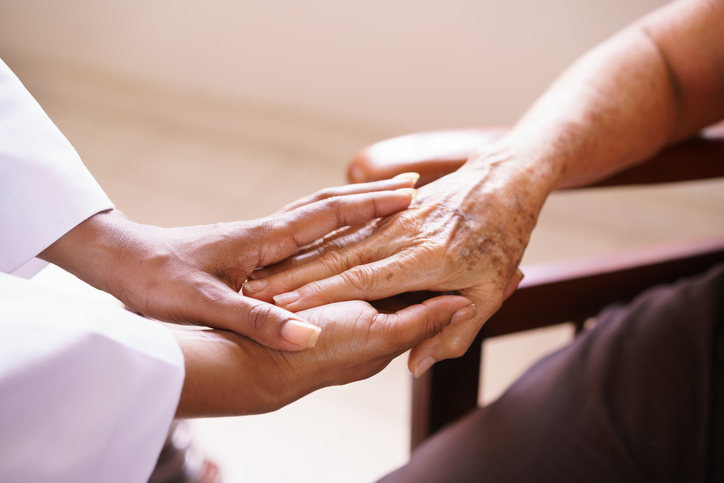
“I can see people again.”
As the number of Americans fully vaccinated against Covid-19 grows daily, the collective feeling of liberation is emerging as the next chapter in our national pandemic story. “I can see people,” declares what we have been deprived of and want to receive — the nourishment of human interaction. However, though our doors are beginning to open, for millions of older adults living alone in their homes, social isolation preceded the crisis and will remain even as the general population’s health is restored and restrictions are lifted. Older people have felt the chill of Covid separation with a particular anguish, knowing that the enduring state of isolation won’t be eradicated by a vaccine.
The Rising Trend of Isolation
The fact is, we’ve never been so alone. One-in-four older Americans live alone, and the trend of solo living is climbing across nearly every age group. Before 1940, almost no one lived alone. A multi-generational family residing under one roof or in close proximity was the norm, and the support necessary for the older members to maintain their quality of life and independence was provided by the close family structure.
But the dislocations of modern life changed that. Swelled by the graying of the U.S. population, the percentage of people living alone is now the highest in our history, as is their desire to remain independent by remaining at home. Ten thousand Baby Boomers are turning 65 every day and 90 percent say they want to live at home. Twelve million currently do. For the ageless generation that personalized the cultural forces of “freedom,” surrendering to what is perceived as a lesser existence is unthinkable. At the same time, this generation’s children live farther away than their predecessors’, making the imperative of caregiving even more complicated and stressful. I know this first hand. My story is no different than that of millions of others whose grandparents and parents want to age in place.
My grandparents were still living without assistance in their home on a Minnesota lake well into their 80s until my grandmother’s physical decline forced my grandfather and their kids into becoming her unpaid caretakers. My parents’ generation had scattered across the Midwest, and we struggled to intervene and provide Tom and Rita with consistent support that would relieve my grandfather’s workload and allow them to age at home. I realized that my grandparents’ isolation was triggering what I thought of as the Social Determinants of Aging (SDoA): housekeeping, technology support, food insecurity, environmental safety, social engagement.
The intersection of Rita’s multiple hip replacements and domestic chores led to day-to-day tasks piling up, though my grandparents’ fine mental health enabled them to continue reading voraciously, trading stocks and engaging intellectually with the world as they always had. Their kids and grandkids did as much as we could, but it wasn’t enough. After several years of shared caregiving, the logistics became untenable and my grandparents were forced to move from their home to a senior care facility.

Reducing Clinical and Staff Burnout with AI Automation
As technology advances, AI-powered tools will increasingly reduce the administrative burdens on healthcare providers.
Our caregiving need disappeared, but so did the independence Tom and Rita craved — the environmental self-determination that gave their lives dignity and meaning. They’re living out their final years physically comfortable, but missing the thing they want most and could have if things were different. Senior living has eased some of their housekeeping demands, but they still need help with medical transportation and appointments, technology help, and grocery shopping, and the forced isolation of this Covid-19 year has prohibited visiting.
Where are the Caregivers?
The nursing-home and assisted-living industries largely began as a response to the fraying of the traditional extended-family unit, filling a deepening void with institutional scale. For a person requiring round-the-clock monitored care, long-term care facilities can be the best option. But for people like my grandparents, that level of caregiving wasn’t what they needed to keep them in their home. My own family’s inability to provide adequate caregiving still frustrates and haunts me. And, if we continue failing to address SDoA despite the historic need, what can my generation expect will happen when we get older? If families can’t provide the caregiving that will sustain independence and quality of life, who can?
The critical shortage of paid caregivers is placing further stress on family members. According to the Bureau of Labor Statistics, 2.9 million more home health aides and personal care aides will be needed to keep up with the skyrocketing demand. However, there is an enormous, untapped, motivated caregiving workforce in this country: parents of school-age children who are interested in working during school hours — the so-called “9 to 3 worker” — but for whom there are few steady, satisfying, paid positions that would fit with their responsibilities. Generally in their 30s to 50s, these people are experienced caregivers, mature, empathic, technologically adept and could be trained to master the skills that would address SDoA and enable this ageless generation to remain independent in their homes in a way my grandparents could not. They can be the force that helps prevent living alone from descending into despair, that prevents independence from withering into aloneness.
The Biden administration has been paying close attention to the potential of this 9-to-3 movement, with CMS introducing “social needs” as a Medicare Advantage and Dual Eligible Medicaid program benefit. These telling first steps are a recognition that the gaps in the current system have placed an untenable burden on unpaid caregivers, at a moment in history when the risks of nursing-home care have been lethally exposed by the Covid-19 virus. It doesn’t have to stay that way. “I can see people again” can include members of a vital, paid caregiver workforce that can reshape what it means to age in place, protecting quality of life for generations to come.
Karl Ulfers is Co-founder and CEO of DUOS. Karl is passionate about empowering older adults to have more freedom as they age because of his own experience helping his loved ones navigate their challenges of aging and struggling to find resources they need to age independently. He is leveraging his experiences as an early leader in digital health starting in 2006 at OptumHealth, part of UnitedHealth Group, and his more recent experience as the Chief Product Officer and then CEO of Rally Health to help DUOS establish a system of aging that makes it easy for older adults and caregivers to get access to the support they need.
This post appears through the MedCity Influencers program. Anyone can publish their perspective on business and innovation in healthcare on MedCity News through MedCity Influencers. Click here to find out how.











